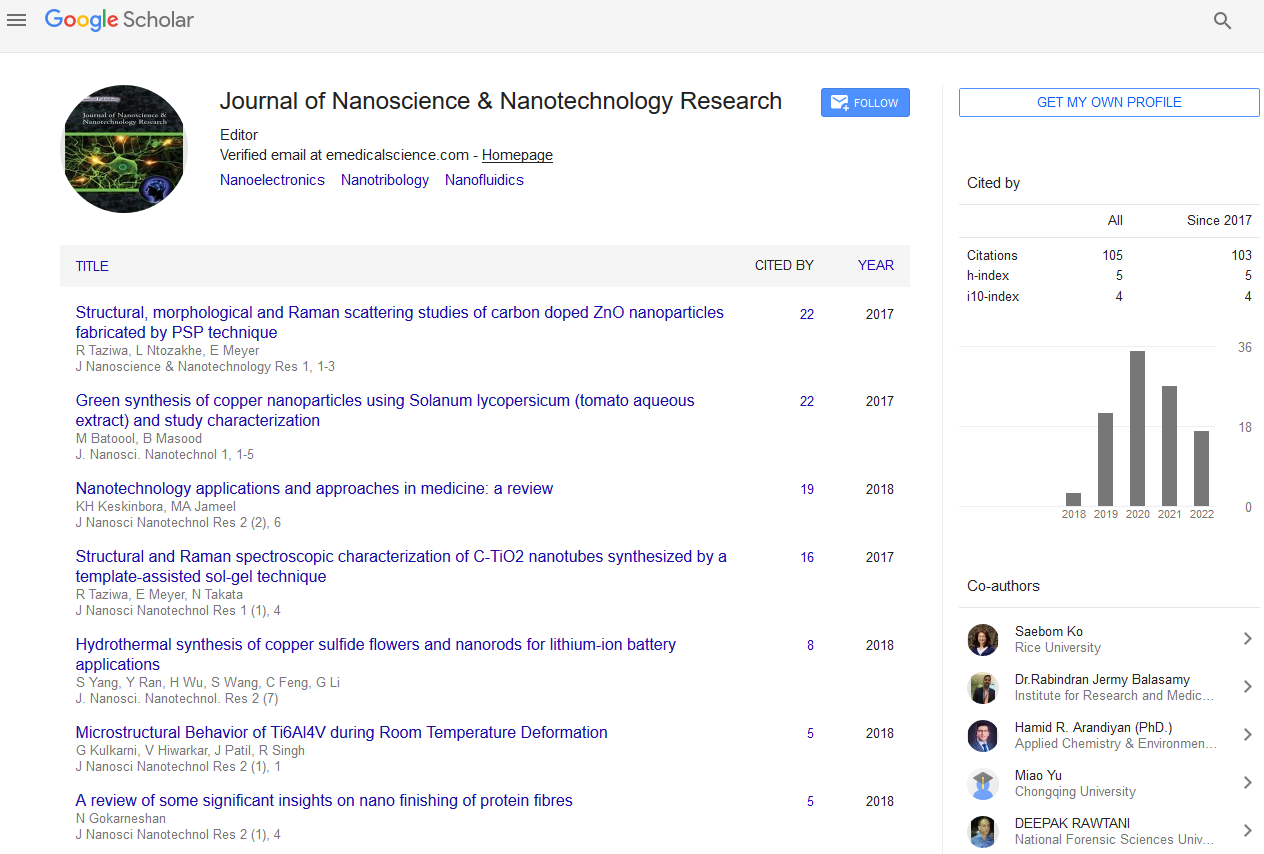Short Communication - (2024) Volume 8, Issue 1
Green Alchemy: Harnessing Nature's Power for Nanoparticle Synthesis
Jeff Lazzari*
Department of Chemical Engineering, McGill University, Canada
*Correspondence:
Jeff Lazzari,
Department of Chemical Engineering, McGill University,
Canada,
Email:
Received: 28-Feb-2024, Manuscript No. ipnnr-24-19592;
Editor assigned: 01-Mar-2024, Pre QC No. ipnnr-24-19592 (PQ);
Reviewed: 15-Mar-2024, QC No. ipnnr-24-19592;
Revised: 20-Mar-2024, Manuscript No. ipnnr-24-19592 (R);
Published:
27-Mar-2024, DOI: 10.12769/IPNNR.24.8.10
Introduction
In the ever-evolving landscape of nanotechnology, a
revolutionary approach is quietly reshaping the field: the
biosynthesis of nanoparticles. By harnessing the power of
nature, scientists are pioneering a greener, more sustainable
method for producing nanoparticles with a myriad of
applications across various industries. In this article, we
explore the ground breaking potential of biosynthesis, its
environmental benefits, and the transformative impact it
promises to have on nanotechnology. Traditional methods
of synthesizing nanoparticles often involve harsh chemicals
and high temperatures, which not only pose environmental
risks but also require substantial energy inputs. In contrast,
biosynthesis offers a more eco-friendly alternative by utilizing
biological organisms such as bacteria, fungi, plants, and even
microalgae to produce nanoparticles. These organisms possess
inherent mechanisms for reducing metal ions and stabilizing
the resulting nanoparticles, making biosynthesis a natural and
sustainable process.
Description
One of the most remarkable aspects of biosynthesis is its
versatility. Nature offers a vast reservoir of biological resources,
each with its own unique properties and capabilities. By tapping
into this diversity, researchers can tailor the biosynthesis
process to produce nanoparticles with specific sizes, shapes, and
compositions, opening up endless possibilities for customization
and optimization. This flexibility is particularly valuable in fields
such as medicine, where the properties of nanoparticles can
be finely tuned to enhance their therapeutic efficacy and
biocompatibility. Moreover, biosynthesis offers significant
advantages in terms of scalability and cost-effectiveness.
Unlike traditional methods that require specialized equipment
and costly reagents, biosynthesis can be performed using
simple and inexpensive materials, making it accessible to a
wide range of researchers and industries. Furthermore, the
use of biological organisms as catalysts eliminates the need
for complex purification steps, streamlining the production
process and reducing production costs. In addition to its
environmental and economic benefits, biosynthesis also holds
promise for improving the safety and biocompatibility of
nanoparticles. By harnessing biological systems, researchers
can produce nanoparticles using non-toxic precursors and
avoiding the use of hazardous chemicals commonly employed
in conventional synthesis methods. This not only reduces the
environmental impact of nanoparticle production but also
enhances the potential for their use in biomedical applications,
where biocompatibility is paramount. The applications of
biosynthesized nanoparticles span a multitude of fields, from
healthcare and biotechnology to environmental remediation
and catalysis. In medicine, biosynthesized nanoparticles are
being explored for drug delivery, imaging, and diagnostics,
offering targeted and personalized approaches for treating
diseases such as cancer and neurodegenerative disorders.
Their unique properties, such as high surface area and surface
reactivity, make them ideal candidates for enhancing the efficacy
and specificity of therapeutic interventions. Furthermore,
biosynthesized nanoparticles hold promise for addressing
pressing environmental challenges, such as water purification,
air filtration, and pollutant remediation. By harnessing the
natural affinity of biological organisms for certain metals and
pollutants, researchers can design biosynthesis processes to
produce nanoparticles capable of selectively capturing and
removing contaminants from the environment. This offers
a sustainable and environmentally friendly approach to
addressing pollution and safeguarding ecosystems. Despite the
immense potential of biosynthesized nanoparticles, challenges
remain in translating laboratory-scale research into real-world applications. Standardizing biosynthesis protocols, optimizing
production yields, and ensuring product consistency are
critical steps in advancing the field. Additionally, addressing
concerns regarding nanoparticle stability, long-term toxicity,
and environmental impact is essential for gaining regulatory
approval and widespread acceptance of biosynthesized
nanoparticles [1-5].
Conclusion
In conclusion, the biosynthesis of nanoparticles represents a
paradigm shift in nanotechnology, offering a greener, more
sustainable approach to nanoparticle production with vast
potential for innovation and impact. By harnessing the power
of nature, researchers are unlocking new opportunities for
addressing pressing challenges in healthcare, environmental
sustainability, and beyond. With continued research and
development, biosynthesized nanoparticles are poised to
revolutionize industries and pave the way for a brighter, more
sustainable future.
Acknowledgement
None.
Conflict Of Interest
None.
References
- Agarwal H, Kumar SV, Rajeshkumar S (2020) Anti-diabetic effect of silver nanoparticles synthesized using lemongrass (Cymbopogon citratus) through conventional heating and microwave irradiation approach. J Microbiol Biotech Food Sci. 9(6):371-376.
[Crossref] [Google Scholar]
- Al-Zoubi MS, Aljabali AA, Pal K (2021) Highly toxic nanomaterials for cancer treatment. Bio Man Nano. 18:161-185.
[Crossref] [Google Scholar]
- Alomari G, Al-Trad B, Hamdan S, Aljabali A, Al-Zoubi M, et al. (2020) Gold nanoparticles attenuate albuminuria by inhibiting podocyte injury in a rat model of diabetic nephropathy. Drug Deliv Trans Res. 10 (1):216-226.
[Crossref] [Google Scholar]
- Al-Trad B, Alkhateeb H, Alsmadi W, Al-Zoubi M (2019) Eugenol ameliorates insulin resistance, oxidative stress and inflammation in high fat diet/streptozotocin induced diabetic rat. Life Sci. 216:183-188.
[Crossref] [Google Scholar]
Citation: Lazzari J (2024) Green Alchemy: Harnessing Natureâ??s Power for Nanoparticle Synthesis. J Nanosci Nanotechnol Res. 08:10.
Copyright: © 2024 Lazzari J. This is an open-access article distributed under the terms of the Creative Commons Attribution License, which permits unrestricted use, distribution, and reproduction in any medium, provided the original author and source are credited.

